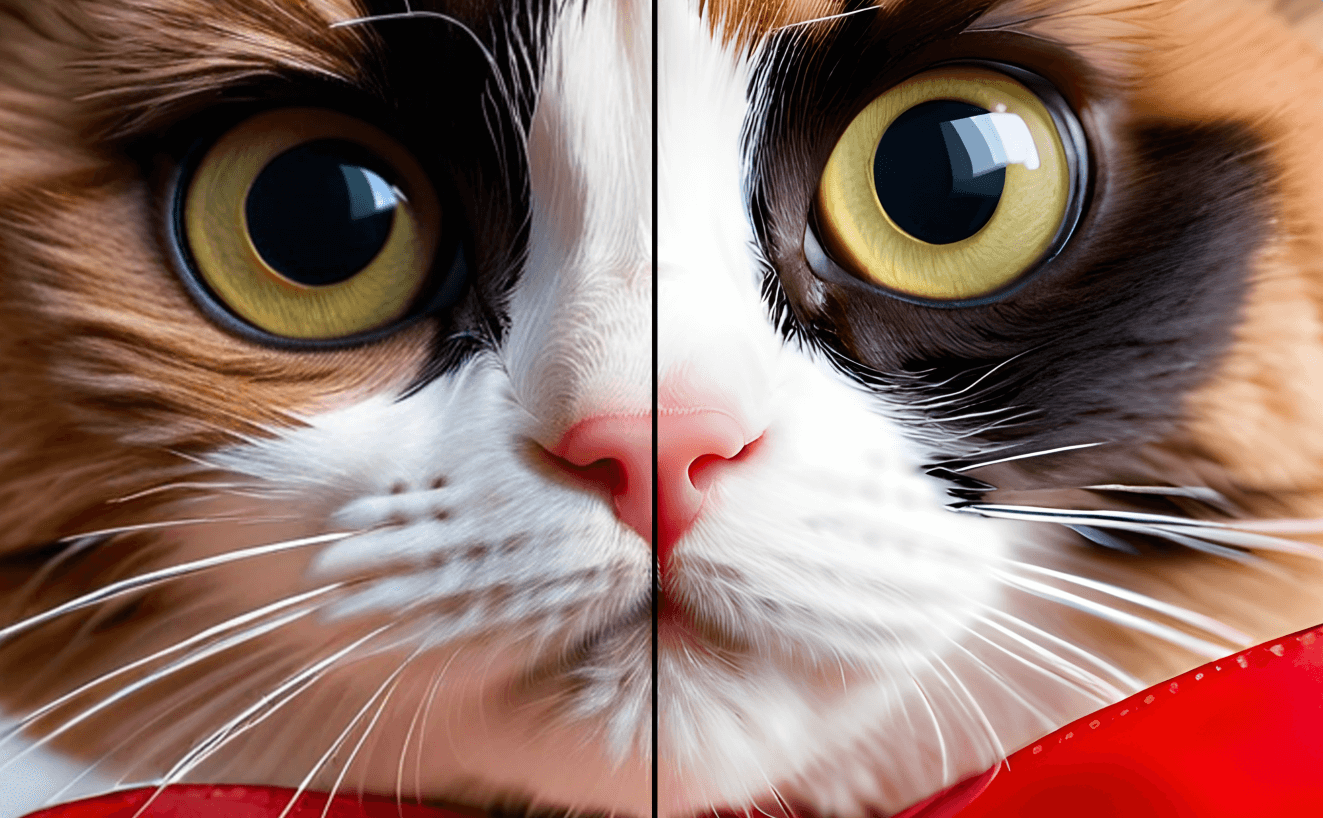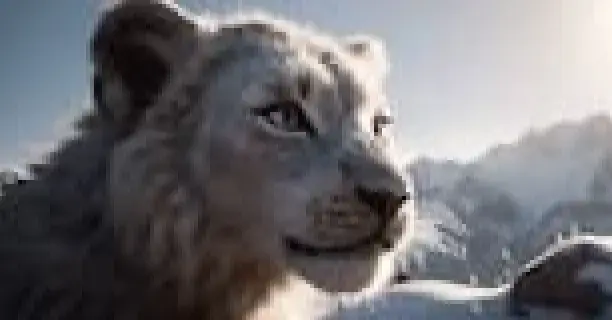You can upscale Midjourney images using an upscaling (also called over scaling) AI. It’s a simple process that can take your generated image from subpar to outstanding.
All you need to do is locate an upscale AI and process your images through it. However, finding a good AI can be a bit of a challenge.
This guide will explain the main reasons why you would want to upscale images, how to generate good images for upscaling and the upscaling process from start to finish.
Plus, we’ll share some tips on turning your Midjourney images into amazing print projects.
Why Do You Need to Upscale Midjourney Images?
You should upscale most Midjourney images because the default resolutions are very low. If you want to use Midjourney for desktop backgrounds, physical prints or products, or even blog posts, it’s best to use an upscaler. Without upscaling, you can only use Midjourney for small scale projects like profile pictures or social media posts.
For example, a printed poster of just 8.5 x 11 inches will need at least 2550 x 3300p to look clear and not blurry. Even a generated image that has been upscaled in Midjourney itself won’t be quite enough for a professional, high-quality poster of this size.
The best way to understand the importance of upscaling Midjourney images is by looking at a real, side-by-side comparison.

What Is The Image Resolution of Midjourney V5?
By default, Midjourney V5’s image resolution is only 1024 x 1024p, or 1 megapixel. There is no longer an internal upscaler in Midjourney’s newest version, much to the dismay of many users. You have to switch from Midjourney V5 to V4 in order to change the resolution again.
Once you’re using V4, you can use the U1, U2, U3, or U4 buttons to upscale. The 4 available resolutions are as follows:
- 512 x 512p
- 1024 x 1024p
- 1664 x 1664p
- 2048 x 2048p
As you can see, even the highest resolution using Midjourney V4 might need more pixel power to create useful imagery. You can quickly get your generated pictures up to snuff by using another AI tool.
There are tens of these AI upscalers out there, but many of them require downloads, force you to sign up for a free trial, or add watermarks if you don’t pay up.
In this tutorial, we will be using the free, completely online image upscaler Imagewith.AI to unlock the true potential of Midjourney’s creations.
How To Upscale Midjourney Images
Step 1: Decide On What Resolution You Need
Before you go any further, you should make a choice about what final resolution and aspect ratio you want. You probably have some projects in mind already. Look up what the expectations and requirements are for those projects, and use that to inform your decision.
Pro Tip: Always upscale your Midjourney image to a higher resolution than you need if you aren’t sure or will use it for multiple projects.
Although those resolutions will usually work, they are only the bare minimum. For projects where you want to cut off part of the image or change the aspect ratio after the fact, an even higher resolution might be necessary.
Speaking of aspect ratio, you should pick a good one for your project before you even start generating. Midjourney uses a 1:1 (square) ratio by default, but that isn’t the best option for most projects.
In Midjourney V5, you can use whatever ratio you want even though you can’t alter resolution. Add the desired aspect ratio to your prompt with “aspect
You’re done with this step when you know both the ideal ratio for your project and the ideal resolution.
Step 2: Generate And Save Your Midjourney Image
Of course, you can’t go any further without generating the Midjourney images you want to use. However, you will have to look out for certain qualities in your AI images since you want to upscale them.
Pay attention to any garbled spots or poorly generated areas. People will usually look at the brightest area of color, human or animal faces, and along leading lines before anything else.
Still, any small error will become magnified when you upscale the image. Even if you plan on doing a thorough bout of editing, it’s best to start with as few problem areas as possible.
Inspect the eyes, body proportions, hands, and continuity in pathways, roads, and objects. These tend to be problem areas and can ruin your final image.
More than anything else, we suggest spending plenty of time with Midjourney before trying to upscale the results.
It’s easier and faster to generate the images you want in batches. Then, you can go over them all at once before moving on.
Save your generations as either JPEG or PNG.
Step 3: Upload Your Midjourney Image to Imagewith.AI’s Upscale Tool
You’re finally ready to start upscaling your image(s) with AI.
Start by navigating to Imagewith.AI’s overscale tool. We recommend using our tool because you won’t be forced to make an account, download software, or apply a watermark. However, the process will be similar with any AI, so feel free to use whatever software you want.
Upload your image to the upscaler and wait for it to render— this should take less than a second.
Step 4: Select a New Resolution and Download
Using Imagewith.AI, you will see two options for upscaling: x2 or x4. Both will come out looking clean and professional, so you should make your choice based on the final resolution you need.
Assuming you’ve been using Midjourney V5, the maximum you can upscale is x2 without a paid subscription. Imagewith.AI lets you scale up to 2560 x 2560p with a free account or up to 16000 x 16000p with even the cheapest paid tier.
Once you’ve selected the right multiplier, press the Overscale button and wait for the AI to do its magic. This will only take a second or two.
Then, press download to become the proud owner of a newly upscaled image.
How to Upscale Midjourney Images for Print
Using Midjourney images for print isn’t the same as using them for an online application. You will need to change some image properties and complete some checks to make sure the print comes out well.
Choose The Right DPI For Printing
Prints, whether on a poster or a t-shirt, use DPI as a measurement.
DPI stands for dots per inch, which is a literal measurement of how many drops of ink are added to the picture. It translates almost directly to PPI, or pixels per inch, for online pictures.
Even small images like posters usually require a minimum of 300 DPI or PPI to look clear. Any lower, and you risk a blurry, unusable print.
So, what does DPI and PPI mean for upscaling Midjourney images?
Well, it means you need to know what DPI you want for your image and change it accordingly. Convert.Town has a DPI conversion tool that can simplify the process.
Changing the DPI will simply make it print at a higher quality, without changing the resolution of the image itself.
Check The True Print Colors
The colors in your Midjourney image won’t look the same in print as they do on your monitor, in all likelihood. You need to check what colors are achievable in print.
Adobe RBG lets you see the colors achievable in print compared to the RBG colors on a monitor. It’s a quick and easy way to make sure things will look how they’re supposed to.
If you don't want to use one of these tools, you don’t have to. Viewing on different monitors and the simple understanding that your image may appear different in person is all you really need.
Format The Image Correctly
The PNG format is ideal for printing because, unlike JPG, it is a lossless format. That means it doesn’t lose data over time, and is usually going to result in sharper printed images.
You can also make a choice between PNG-8 or PNG-24. This is a distinction in how much color is saved in the image. PNG-8 is workable, but PNG-24 is better for images with a lot of color variation.
Use Soft Proofing And Hard Proofing
Before the advancement of photography software, hard proofing was used to test an image print. Hard proofing means printing out a physical copy of the image, and making adjustments from there.
If you’re inexperienced, you may want to use hard proofing. However, soft proofing is the easier option because it can be done entirely in software like Adobe Lightroom and Photoshop.
Soft proofing will let you look at mockup results using different color spaces and printers. You can then change the image properties accordingly within the same software..
Conclusion
As you continue to process your Midjourney images, you might need to use some other AI tools to reach the refinement you want. Imagewith.AI has a full suite of tools you can use for image enhancement.
For example, you might want to remove the main subject of your AI image without the strange backdrop. You can use Imagewith.AI’s outcut tool for that.
Or, you could remove unwanted objects– like AI generations you didn’t want– with Imagewith.AI’s clearoff tool.






